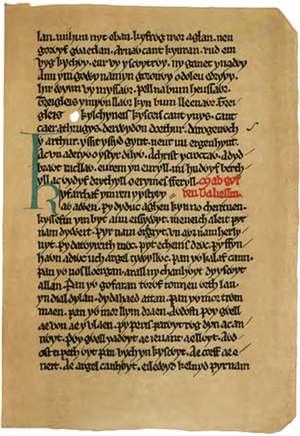The famous scene in Star Wars: Episode I-The Phantom Menace, the climactic duel between fan-favourite Darth Maul and the Jedi Qui-Gon Jinn and Obi-Wan Kenobi has a deep connection to Medieval Welsh poetry.
Overall, the poem describes a conflict between the sons of the Goddess Dôn and the forces of the Welsh otherworld, Annwn (the Sons of Dôn are comparable to the Irish Tuatha Dé Danann). It is initiated by Gwydion's brother Amaethon and Lleu Llaw Gyffes, a heroic figure and nephew of Gwydion, also takes a noticeable role in the battle at Caer Vevenir.
Although Star Wars and Welsh poetry seem to completely separate subjects, the fact that there is a connection may not be much of a surprise. A high level of thought can go into creating cinema and George Lucas certainly drew inspiration from a wide range of historic and mythological sources. The obvious parallels lie between the Galactic Empire and Nazi Germany, Chancellor Palpatine and Adolf Hitler. However, if Ian McDiarmid (the actor who plays Palpatine) is to be believed in an article from The Guardian the future Galactic Emperor also drew inspiration from Richard Nixon. Therefore, we can see that a link between The Phantom Menace's climatic scene and Welsh poetry is not as far-fetched an idea as it may initially seem.
In this special article due to it being May 4th a.k.a Star Wars Day, I shall explore this engrossing connection, between the Duel in the Theed Generator Complex or the 'Duel of the Fates' and a Medieval Welsh poem Cad Goddeu.
This is one of the most popular duels in the Star Wars mythology, it is easy to see why with the choreography. But the music also stands out and in general feels quite epic or operatic, this is no surprise considering the reputation of John Williams, the composer of the piece. Perhaps, his more famous works are iconic pieces such as 'The Imperial March' and 'Star Wars Theme'.Yet, this piece, entitled the 'Duel of the Fates', in my opinion is still one of the most memorable cinematic themes, especially when it comes to Star Wars in particular.
However, the lyrics of this song, which in my opinion are hard to identify while watching the scene, are wrote in Sanskrit. Sanskrit is the primary sacred language of Hinduism, it also has philosophical usage in Hinduism, along with Buddhism, Sikhism and Jainism. It is also a literary language (thus different in some ways to the spoken language) and was the lingua franca in Greater India and the Kingdom of Nepal (this refers to a common language that people use, if they do not share the same native language). A controversial issue, the spoken form of the language has seen attempts of revitalisation, with 14.346 self-reported speakers. However, it maintains popular usage in Buddhist hymns and chants and ceremonially in Hinduism.
For me it is much clearer to notice the lyrics when you simply listen to the orchestral piece without the action in the foreground. The Sanskrit lyrics originate from a fragment of an archaic Welsh poem Cad Goddeu or the Battle of the Trees. It was preserved in the 14th century Book of Taliesin, most of the contents of this date from the 10th century or earlier. Although, it is incomplete, it contains some 60 Welsh poems. Furthermore, it is important to take into account, that Taliesin the poet which many of the poems are attributed to, was actually active in the late 6th century, he (like some of the other potential authors) wrote in the Cumbric dialect of Hen Ogledd (a region of Northern England and the Scottish Lowlands inhabited by Celtic peoples, in the post-Roman period.) The poem records a traditional Welsh story in which Gwydion, a magician, trickster and hero of Welsh mythology animates an army of trees to fight for him.
The picture above shows a folio (13) of the Book of Taliesin, which can be found at the National Library of Wales. Cad Goddeu is composed of 248 short lines, with the poem being easily divisible in different sections.
The first proclaims a first-hand knowledge of all things.
I have been a tear in the air,I have been the dullest of stars.I have been a word among letters,I have been a book in the origin.I have been the light of lanterns,
There is then an account of a great monstrous beast.
Cad Goddeu then tells us of the fear of the Britons and how with Gwydion with his skill and by the grace of God, the trees were animated for combat. Trees and plants are now listed, each one having unique attributes.There passed an animal with wide jaws,On it there were a hundred heads.And a battle was contestedUnder the root of his tongue;And another battle there isIn his occiput.
The alder trees, the head of the line,
Formed the van.
The willows and quicken trees
Came late to the army.
Plum-trees, that are scarce,
Unlonged for of men
The poem continues with an account of the birth of the flower-maiden Blodeuwedd in first-person. It then follows this up with an account of a great warrior who was once a herdsmen and is now a learned traveller. This could be Taliesin himself or Arthur Pendragon (King Arthur). A rather interesting point is how the poem ends with an obscure reference to metalwork. It is also important to mention how the poem is inter-laid with Christian themes throughout, thus pointing towards Christianisation in practice.
A golden gem in a golden jewel.I am splendidAnd shall be wantonFrom the oppression of the metal-workers
Overall, the poem describes a conflict between the sons of the Goddess Dôn and the forces of the Welsh otherworld, Annwn (the Sons of Dôn are comparable to the Irish Tuatha Dé Danann). It is initiated by Gwydion's brother Amaethon and Lleu Llaw Gyffes, a heroic figure and nephew of Gwydion, also takes a noticeable role in the battle at Caer Vevenir.
The front cover (as seen above) for the one-track promotional release of 'Duel of the Fates' interestingly depicts the Duel on Tatooine, rather than the final duel on Naboo. Interestingly, Williams aimed for a religious and sacred feeling in his track for this duel, thus the use of Sanskrit seems to fit well. He stated that the setting of the lightsaber duel felt like a pagan altar. The chorus also evokes a ceremonial aspect, Williams stated it seems that the death of one of the combatants seems inevitable. The meditation of Qui-Gon Jinn, when the laser barriers are up, seems to be symbiotic with the orchestral score in the pursuit of a feeling of sacredness.
With the context of the 'Duel of the Fates' in mind, the use of Sanskrit,and the sacred Christian references in Cad Goddeu, combined with its also mythological and pagan aspects, it is easy to see why Williams created the piece and why it has became so iconic. It was used as inspiration for 'Battle of the Heroes' the piece used during the duel on Mustafar between Obi-Wan Kenobi and Darth Vader, not long ago Anakin Skywalker, the piece is now tragic. Nevertheless, the 'Duel of Fates' has also found home in Revenge of the Sith's duel between Yoda and Palpatine and furthermore in multimedia, mostly now considered Legends material, such as video games like Star Wars Battlefront II, Lego Star Wars and Star Wars: The Force Unleashed. It has also recently appeared in the canon animated TV series Star Wars Rebels, with a duel between Darth Vader and his former apprentice Ahsoka Tano being the context.
Regardless, I hope this article shows the history and story behind an iconic and memorable piece of cinematic orchestral music. If you have enjoyed this article and want to read more history related posts, please follow me. You could also share this article, or comment below. If you have any suggestions for articles on any area of history then please recommend them to me in the comments sections, even if the idea draws from popular culture like this article.Perhaps I could find a connection between your favourite interest and history. Thanks for reading and May the 4th be with you.
Dosclaimer: I believe any images and videos I have used fall under the remit of fair user. I do not claim ownership of this material.
Image credit goes to Wikipedia and Wookiepedia
Sources:
http://www.ancienttexts.org/library/celtic/ctexts/t08.html
http://www.ancienttexts.org/library/celtic/ctexts/t08.html
http://starwars.wikia.com/wiki/Duel_of_the_Fates
http://www.theguardian.com/stage/2005/nov/07/theatre1


.jpg)

No comments:
Post a Comment